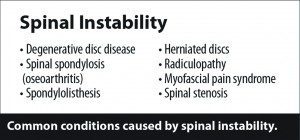By Debra K. Brinker, RN
Low back pain is one of the most common musculoskeletal pain conditions in the United States, causing individuals physical, social, emotional and economic hardships. The disability from low back pain is so predominant that almost half of the population of the United States has experienced it at some point. Often, it is the result of an injury, possibly due to sudden movements and poor body mechanics or from trauma during a sports activity, fall or motor vehicle accident. Diseases such as infections, endometriosis, fibroids and cancer can also cause low back pain and need to be ruled out. Acute injuries, such as minor muscle strains, frequently heal quickly due to the great blood supply and healing capacity of the muscles. However, many low back pain sufferers deal with chronic pain, and all too often the underlying cause is not identified.
Many of the modalities used to treat low back pain only provide short term relief because they are typically used to treat the symptoms. Treatments, such as over-the-counter (OTC) pain medication, nonsteroidal anti-inflammatory drugs (NSAIDs), steroids, cortisone injections, and massage give some relief, but with chronic low back pain, the pain tends to return, because these treatments are not reparative. Imaging tools are helpful, but may be misleading if the practitioner does not correlate the findings with the painful areas and tender points found during the physical and functional exams. Consider, for example, a bulging disc. Upon bending forward, the disc bulges posteriorly and when bending to the left, the disc bulges to the right. Therefore, a bulging disc doesn’t necessarily mean a pain-eliciting disc. Surgery is a necessary tool in some cases, but surgery for non-specific low back pain has not been shown to have clear benefit, and may result in Failed Back Surgery Syndrome.
Ligaments: The Source of Musculoskeletal Chronic Low Back Pain
The common denominator for many painful musculoskeletal conditions causing low back pain is spinal instability due to injury to ligaments. Ligaments are structures joining bone to bone, and in the low back or lumbar spine, connect adjacent vertebrae and facet joints. Ligaments serve as one of the primary stabilizing structures of the spinal column, providing adequate motion and restricting excessive motion, and in doing so protect the spinal column and nerve roots as they exit the spine.


The lumbar spine is called upon to maintain an upright posture, bend, turn and sit, which places a lot of stress on the soft tissue structures in the back, including the ligaments. The function of the ligaments involves the transfer of these numerous loads from bone to bone and to manage the forces placed on the spine. But when loads and forces exceed their tolerance, ligaments weaken and become lax, similar to a rubber band that has lost its elasticity. [See Figure 1.] When this occurs, the injured ligaments are unable to provide adequate stability to the lumbar spine.


Ligaments are highly innervated, and with injury, will elicit pain. Therefore, with bending, turning and other engagement of the vertebrae of the lumbar spine, the nerve fibers in the ligaments start firing and sending pain signals. Other symptoms of lumbar instability include a feeling of the back giving out, cracking sensations with movement, catching or locking, a frequent need to crack the back and recurrent muscle spasms. [See Figure 2.] Unaddressed, this condition of spinal instability produces chronic low back pain.
In addition, spinal instability allows for excessive mobility or hypermobility of the vertebral segments, producing too much pressure on the discs due to the altered joint mechanics, which then fosters degeneration and disc herniation. [See Figure 3.] 

Non-surgical options for low back pain
Physicians in the Regenerative Medicine field have made natural injection treatments, such as Prolotherapy and Stem Cell therapy, a convenient option for patients looking for non-surgical, long-term correction of low back pain. Regenerative injection therapies offer not only pain relief, but healing at the source. Prolotherapy is a treatment directed at the injured and lax ligaments, to re-start the body’s own repair cascade, which in turn stabilizes the vertebral segment, eliminating the excessive movement and resolving the pain. In more advanced cases, a person’s own cells (from fat tissue, bone marrow, or blood) can be used to rejuvenate the degenerated areas, called Stem Cell Prolotherapy. Patients typically require approximately 3-6 treatments, and are able to maintain normal activities and athletics, making these effective options that can provide sustained pain relief with minimal lifestyle interruption.
Regenerative Medicine Specialists
CaringMedical.com
239-303-4546
with locations in Fort Myers and Chicagoland
 Southwest Florida's Health and Wellness Magazine Health and Wellness Articles
Southwest Florida's Health and Wellness Magazine Health and Wellness Articles

